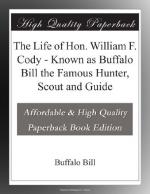Scott and Charley were great lovers and consumers of “tanglefoot,” and they soon got gloriously drunk, keeping it up for three days, during which time they gambled with the ranchmen, who got away with all their money; but little they cared for that, as they had their spree. They finally sobered up, and we resumed our journey, urging our jaded animals as much as they could stand, until we struck Marysville, on the Big Blue. From this place to Leavenworth we secured first-rate accommodations along the road, as the country had become pretty well settled.
It was in February, 1859, that I got home. As there was now a good school in the neighborhood, taught by Mr. Divinny, my mother wished me to attend it, and I did so for two months and a half—the longest period of schooling that I ever received at any one time in my life. As soon as the spring came and the grass began growing, I became uneasy and discontented, and again longed for the free and open life of the plains.
The Pike’s Peak gold excitement was then at its height, and everybody was rushing to the new gold diggings. I caught the gold-fever myself, and joined a party bound for the new town of Auraria, on Cherry Creek, afterwards called Denver, in honor of the then governor of Kansas. On arriving at Auraria we pushed on to the gold streams in the mountains, passing up through Golden Gate, and over Guy Hill, and thence on to Black Hawk. We prospected for two months, but as none of us knew anything about mining we met with very poor success, and we finally concluded that prospecting for gold was not our forte. We accordingly abandoned the enterprise and turned our faces eastward once more.
[Illustration: RAFTING ON THE PLATTE.]
When we struck the Platte River, the happy thought of constructing a small raft—which would float us clear to the Missouri and thence down to Leavenworth—entered our heads, and we accordingly carried out the plan. Upon the completion of the raft we stocked it with provisions, and “set sail” down the stream. It was a light craft and a jolly crew, and all was smooth sailing for four or five days.
When we got near old Julesburg, we met with a serious mishap. Our raft ran into an eddy, and quick as lightning went to pieces, throwing us all into the stream, which was so deep that we had to swim ashore. We lost everything we had, which greatly discouraged us, and we thereupon abandoned the idea of rafting it any farther. We then walked over to Julesburg, which was only a few miles distant. This ranch, which became a somewhat famous spot, had been established by “Old Jules,” a Frenchman, who was afterwards killed by the notorious Alf. Slade.




